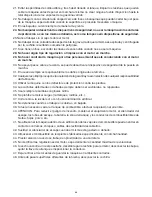
11
– the hydraulic motor fins are clean (Fig. 7);
– the blades are sharp and firmly fastened in place;
– the screw in the centre of the blade hub is securely tightened (3, Fig. 1/C)
Fill the fuel tank using a funnel with very fine filter (4, Fig. 1/A).
STARTING UP THE ENGINE
– Push the throttle half way in (5, Fig. 1/B)
– If the engine is cold, use the choke (6, Fig. 1/B). Turn the ignition key on the dashboard (7, Fig. 1).
– Once the engine has started, turn off the choke and wait for a few minutes to allow the engine to warm up.
N.B. When moving the mower from one place to another, you are advised to keep the cutting plate at the
maximum height setting.
STARTING WORK
– Choose the desired cutting height by means of the lever 8 Fig. 1/D. Suitably accelerate the engine and
engage the PTO lever (1, Fig. 1). Gently operate the forward travel lever (2, Fig. 1/B) and start work.
To stop, return the forward travel lever to the stop position.
– The lever (2, Fig. 1/B) is also used to reverse. When it is moved back, the machine moves backwards;
always operate it gently.
FORWARD BRAKE
The forward brake (Fig. 23 n
°
1) must be used only as an emergency brake sloping down, to avoid the
machine sliding. (When it is used with the differential lock, it makes the machine steadier sloping down).
The forward travel lever is normally used to decelerate and to brake.
PARKING BRAKE
To engage the parking brake, please press the lever downwards and lock it to the proper seal retainer
(fig. 23 n. 2); in this position, if the forward travel lever is engaged, an acoustic signal warns that the parking
brake is engaged.
To adjust the parking brake, use the castellated nut (fig. 22).
USEFUL RULES FOR EFFICIENT USE
1) Never strain the engine: when fumes are emitted from the exhaust it means that it is being strained.
Slow down.
2) Do not leave the machine out in the rain.
3) If the machine heats up on the first day at work, stop it and allow it to cool down: it needs to rest.
4) Frequently sharpen the mower blades: the cut will be better and the engine will not be strained as much.
5) Check the land before mowing to make sure that there are not any stones, sticks or foreign bodies.
6) Keep the engine at peak r.p.m. during mowing, adjust the speed according to the height of the grass.
7) Keep the grilles above the engine and the cooling fins of the hydraulic motor (Fig. 3/A) clean.
CUTTING POSITIONS
The cutting position is adjusted using the lever 8 Fig. 1/D.
The plate can be set in 4 different cutting positions from 30 to 90 mm and one travel position in which the
blade disengages automatically Fig. 1/D.
In case of uneven ground, humps or dips, the plate should be kept in the highest cutting position to prevent
knocks by the blade.
SLOPING GROUND
If possible, steep slopes must be mown in the up/down direction, taking great care when turning that the
wheels upstream do not strike obstacles (stones, branches, roots, etc.) which might cause the machine
to overturn, or lead to loss of control. If the drive wheels tend to slip, use the differential lock (Fig. 8).
Pressing engages this – it disengages automatically when the pedal is released.
Assess the conditions and take care if the ground and grass are damp since the machine might
slip.
Downhill, set off at low speed and do not pass over dry or cut grass since the wheels lose grip.
INTERVENTION OF SAFETY DEVICES
Remember that the engine will stop whenever:
– The operator gets up from the seat.
Summary of Contents for Climber 9.16
Page 2: ......
Page 4: ......
Page 5: ......
Page 6: ......
Page 7: ......
Page 8: ......
Page 36: ...34 Fig 3 A Fig 3 Fig 1 C Fig 1 Fig 1 A Fig 1 B 1 7 4 2 5 8 Fig 1 D 6 3 Fig 2 ...
Page 37: ...35 Fig 9 Fig 10 Fig 7 Fig 8 Fig 5 Fig 6 Fig 4 Fig 11 A B Oil level ...
Page 38: ...Fig 11 A Fig 15 Fig 16 Fig 13 Fig 14 A B 44 mm Fig 17 Fig 14 A Fig 12 A A 36 ...
Page 39: ...Fig 19 Fig 20 B Fig 20 A Fig 21 Oil A B Fig 18 Fig 22 37 Fig 23 1 2 ...
Page 43: ......
Page 44: ......














































